Table of Contents
This section discusses the design of BigWorld Server environment, with a brief overview of its components and a series of Use Cases.
The BaseApps and the LoginApps are the only server components that need to be connected to the Internet.
For security purposes, it is recommended that the BaseApp and LoginApp machines have two network cards; one to connect to the Internet, and the other to connect to the rest of the server cluster.
The diagram below shows the connection between the different components of server hardware.
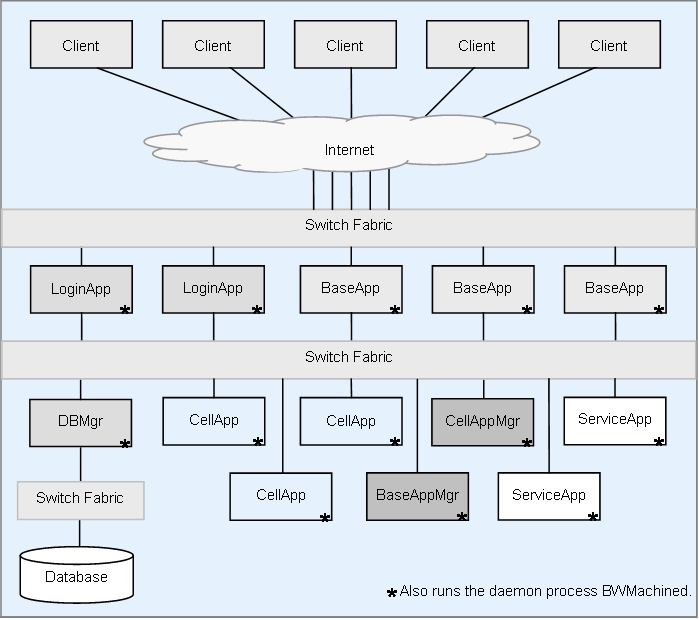
BigWorld Server components
The primary software components of the server are:
-
CellApp
-
CellAppMgr
-
BaseApp
-
BaseAppMgr
-
ServiceApp
-
LoginApp
-
DBMgr
-
Reviver
There is also a special daemon process called BWMachined, which runs on each machine.
In a production environment, each CellApp runs on its own CPU, as does each BaseApp and ServiceApp. All other processes (apart from BWMachined) can be organised to run in various combinations across one or more servers, depending on system loads.
Only BaseApps and LoginApps are required to be connected to the internet.
ServiceApps and Revivers are optional. All other processes are required.
The diagram below shows the communication paths between many of the software components:
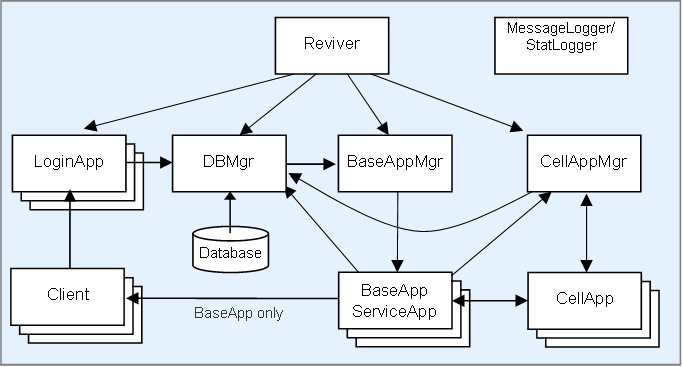
Communication between BigWorld components
Each CellApp is responsible for all cells running on it.
CellApps are probably the most important part of the architecture. Each cell is responsible for either part of a large space or an entire one. Within the game world, cells do not overlap, and collectively they cover all game spaces.
Each cell is responsible for maintaining the entities located within its boundaries. The entity is the basic element of operations within the BigWorld game environment. Its distinguishing feature is its point position in a space. A cell may also keep ghosts (copies) of entities that are near, but outside its own boundary.
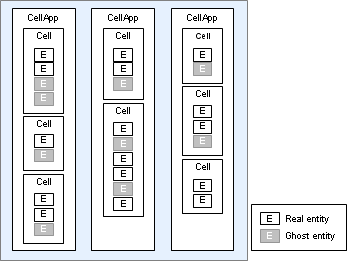
CellApps managing cells
The main responsibility of the CellAppMgr is to direct the cells and CellApps.
It coordinates which cells run on which CellApps, and balances the load on each of them by varying the size of the cells.
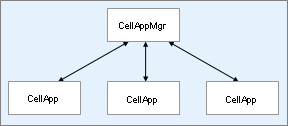
CellAppMgr managing CellApps
In some respects, BaseApps can be seen as the firewalls for the server.
For the client, their main purpose is to isolate it from transitions of its entity between CellApps.
Each BaseApp contains many bases.
Connected clients are served by an enhanced base known as a proxy. Each proxy is responsible for at most one client. Each client talks to one proxy. This proxy is responsible for redirecting messages from the client to the correct cell.
In general, the BaseApp maintains bases. A base represents an object or function that does not need to have a position in the world.
For example, an object used for group chat is a base without a corresponding cell entity.
Any cell entity can have a corresponding base entity, giving it a fixed point of contact in the game world.
A base is also considered to be part of an entity, so a proxy is the 'base entity' for a client, which will usually have a related 'cell entity' part, as well as a 'client entity' part instantiated on any clients that can see it.
The game world has a single BaseAppMgr running, which is responsible for managing the BaseApps and ServiceApps.
Its main job is to allocate new client connections to the most appropriate BaseApp, and keep track of them.
ServiceApps are processes that support running Services.
A Service can be thought of as a Base-only entity, except that instead of representing an object, it provides an interface between the game server and some external service. It could also provide functionality that may otherwise have been implemented as a singleton Base-only entity. A Service has no properties.
A ServiceApp is a specialised BaseApp containing Service fragments instead of Base entities. A single Service can have fragments on multiple ServiceApps, allowing that Service's functionality to be available on multiple machines.
The ServiceApp executable is actually a symbolic link to the BaseApp binary. It causes the BaseApp to be run in a different mode. By default, Base entities will not be created on ServiceApps. Unlike BaseApps, ServiceApps do not need a direct connection to the internet.
Clients talk to this component to initiate a session with the server. The LoginApp then adds the player as a proxy on a BaseApp, which may go on to create an entity on a CellApp.
Multiple instances of this component can be running at once.
DBMgr is the interface to the database, where the persistent state of the world is stored.
When a player logs in, the login process requests from the database the full set of properties for that player's entity. This data is used to instantiate a proxy for the player on the BaseApp.
When the player logs out, the BaseApp sends a logoff message to the database. This message contains the player's entity's properties, which may have been modified by the base (or cell) entity.
Reviver is a watchdog process used to restart other processes that have failed, either because the machine they were running on has failed, or because the processes themselves have crashed or are unresponsive.
BWMachined is a daemon process that runs on each machine in the server cluster. It can be used to remotely start, stop, and locate server components. It also monitors CPU, memory, and network usage, and provides this information to network users.
This is how server components locate each other during startup, via a broadcast message. Its operation is similar to a CORBA Name Server.
This daemon must be running at all times on each machine in the server's cluster, and must be started as root. For installation instructions, see the document Server Installation Guide.
This section describes how some of the functionality of the server works. It is intended to give an introductory view of the components in the server, and how they relate to each other.
The important things about startup are the dependencies between processes and how different processes find one another.
As mentioned in BWMachined, BWMachined runs on each machine in the server cluster, and is responsible for monitoring the processes running on its machine.
When a process starts up, it registers itself with the daemon running on the local machine. The registration includes an interface name.
Many processes need to know the location of other processes.
For example, a CellApp needs to know the location of a CellAppMgr, so that it can register with it. So when CellApp starts up, it asks for the location of a CellAppMgr by sending a broadcast message on BWMachined's port, to which all BWMachined processes listen. If a BWMachined has a CellAppMgr (associated with the correct user), it sends the CellAppMgr's contact details as a response.
Note
The BWMachined daemon should always be running on each machine in the server cluster.
When a client starts up, it communicates with LoginApp (for more details, see LoginApp).
The login process follows the steps below:
-
Client sends a login request (for which it needs to know LoginApp's IP address).
-
While listening to its fixed (user-specified) port, LoginApp receives the request.
-
LoginApp forwards the request to DBMgr, so it can check if login details are valid.
-
DBMgr queries the database regarding login details.
-
If the details are valid, DBMgr instructs BaseAppMgr to create a new entity.
-
BaseAppMgr forwards entity creation request to the least loaded BaseApp.
-
BaseApp creates new proxy, which is an object derived from Base class.
-
The newly created proxy now may create the cell entity on a CellApp (this step might be delayed by the proxy until client selects a character, for example.).When creating the cell entity, the proxy may send a message via the CellAppMgr or directly to a CellApp
-
The UDP port of the proxy is returned to the client (via BaseAppMgr, DBMgr, then LoginApp).
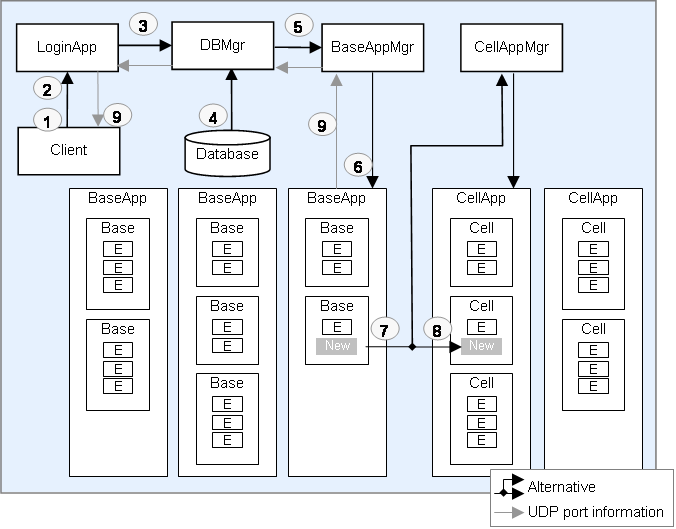
Login process
All communication from the client to the server is sent to the address of the client's proxy that was sent to it during login.
This communication uses Mercury (the BigWorld communication mechanism) on top of UDP. Once the proxy receives the packet, it forwards the messages (generally most, if not all) to the appropriate CellApp. This will then update the data of the appropriate entity. If the entity has any ghosts, these are also updated.
Periodically, at 10 Hertz (configurable), the client's cell entity constructs a packet full of messages about the entities in the client's AoI. This packet is then sent via the proxy to the client.
Each client's entity keeps a priority queue of other entities in its AoI. One issue that arises is that not all these entities might be on the same cell. The solution to this is ghosting.
A ghost is a copy of an entity from an adjacent cell. The ghost copy contains all data that may be wanted when other entities are going through their priority queues to construct their update packets. If there is a possibility that an entity is within the AoI of another entity in a different cell, it must have a ghost in that cell. To achieve this, if an entity is within the AoI distance (or ghost distance) of a cell boundary, BigWorld creates a ghost of the entity on that cell.
When a real entity (i.e., the master, non-ghost entity) is updated, it updates its ghosts as well, if any.
As an entity moves around, it may actually leave the boundary of the cell it is currently on. When this occurs, the entity is moved to the relevant new cell. It then informs the base of its new address, so that the base can find it in the future (and in the case of a proxy, so that the proxy can continue to forward messages correctly).
A CellApp machine, like any other machine, has a limit to the load it can handle. To avoid some CellApps getting overloaded, there is a mechanism to balance the load. In general, if a cell is overloaded, then it reduces its size, thus offloading some entities. If it is underloaded, it increases its size to assume control of more entities.
